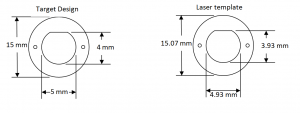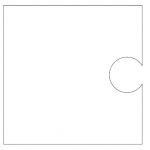 I wanted to connect a Nema17 stepper motor to a 5/16″ lead screw. Traditionally you would just go out and buy an aluminum coupler but there are issues with doing that. Finding a supplier for a coupler with a metric hole size on one end and an imperial hole on the other is not easy. To compound the supply issue, the lead times for buying a coupler are 3-6 weeks. I wanted to test different motor and lead screw combinations so I needed a way to rapidly prototype different solutions. If I had access to a lathe I would just machine the part but I don’t so I went in search of other solutions. In this article I will describe how I laser cut parts to build custom couplers.
I wanted to connect a Nema17 stepper motor to a 5/16″ lead screw. Traditionally you would just go out and buy an aluminum coupler but there are issues with doing that. Finding a supplier for a coupler with a metric hole size on one end and an imperial hole on the other is not easy. To compound the supply issue, the lead times for buying a coupler are 3-6 weeks. I wanted to test different motor and lead screw combinations so I needed a way to rapidly prototype different solutions. If I had access to a lathe I would just machine the part but I don’t so I went in search of other solutions. In this article I will describe how I laser cut parts to build custom couplers.
 The design I present here consists of 4 laser cut MDF washers that are cut with shaft keying. The Nema17 motor has a 5mm shaft with a flat on one side so I designed a washer that would make a tight fit on the shaft. The Zing laser I’m using has a +-0.07mm cutting kerf so I take this into account when designing the washer. The shaft hole needs to be designed as 5mm – 0.07mm so that the final hole size including the kerf is exactly 5mm.
The design I present here consists of 4 laser cut MDF washers that are cut with shaft keying. The Nema17 motor has a 5mm shaft with a flat on one side so I designed a washer that would make a tight fit on the shaft. The Zing laser I’m using has a +-0.07mm cutting kerf so I take this into account when designing the washer. The shaft hole needs to be designed as 5mm – 0.07mm so that the final hole size including the kerf is exactly 5mm.
To align the four washers during assembly and to keep the structure from breaking apart during use I have added 2 piano wire pins to the design. When the pins are installed all of the washers are aligned and they are structurally enhanced by the steel reinforcement that won’t twist while the coupler is used.
 The threaded lead screw does not come with a flat on the end of the shaft so this needs to be ground or filed into the threaded shaft. To maintain the tightest tolerance I created a template for grinding the flat to size. The template consists of a hole that is the diameter of the lead screw. The hole is offset in the template so that the portion of the lead screw that is to be ground is exposed and can be ground flush to the template. This process worked well and I am able to get a consistently tight fit between the shaft and the coupler washer.
The threaded lead screw does not come with a flat on the end of the shaft so this needs to be ground or filed into the threaded shaft. To maintain the tightest tolerance I created a template for grinding the flat to size. The template consists of a hole that is the diameter of the lead screw. The hole is offset in the template so that the portion of the lead screw that is to be ground is exposed and can be ground flush to the template. This process worked well and I am able to get a consistently tight fit between the shaft and the coupler washer.
I noticed that while I can get a tight rotational fit, the motor and lead screw can still slip lengthwise. To limit this I will drill a hole into the side of the coupler and add a hex key. The MDF is soft enough that it can be self tapped so I only need to drill two holes. The first design used white glue to hold it together but I will try epoxy on the next parts.
1 comment for “Designing a lead screw coupler”